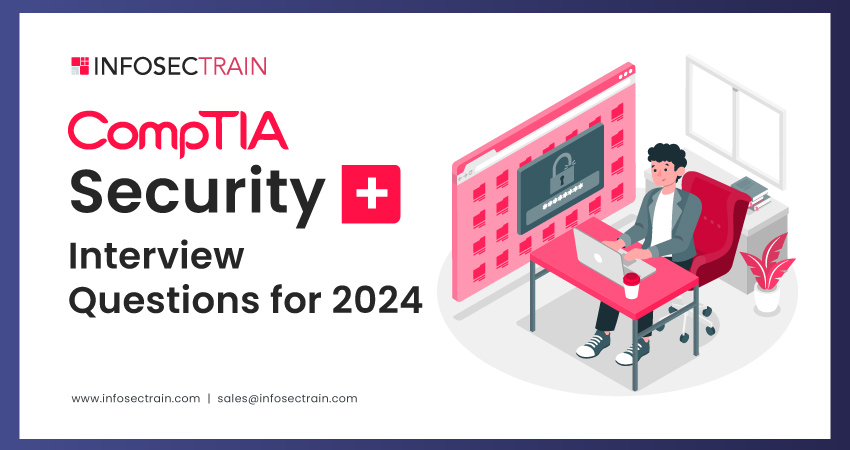CompTIA Security+ Interview Questions for 2024
In the present era, the abundance of access points, public IPs, constant traffic, and vast amounts of exploitable data provide hackers ample opportunities to exploit vulnerabilities and develop malicious software for financial gain. As a result, there is a significant demand for cybersecurity professionals across various industries. Even with many certified cybersecurity professionals available, getting the CompTIA Security+ certification offers a valuable opportunity to acquire crucial cybersecurity skills. If you are a certified CompTIA Security+ professional gearing up for a cybersecurity job interview. Here are some of the latest interview questions.

Q1. Why is establishing a security baseline important within an organization?
An organization’s security baseline is crucial as it sets the minimum security standards for systems and networks. It ensures a uniform and secure configuration, thereby minimizing vulnerabilities across the infrastructure. Taking a proactive stance is crucial for boosting cybersecurity across the board.
Q2. What does the term “Man-in-the-Middle (MitM) attack” mean?
A Man-in-the-Middle attack occurs when an unauthorized third party intercepts and potentially modifies communication between two parties without their awareness, posing a significant risk to the confidentiality and integrity of data. This attack involves an unauthorized entity secretly manipulating the exchange of information, compromising the security of the communication process.
Q3. Identify the essential components of a disaster recovery plan.
- Backup Procedures
- Data Recovery Processes
- Communication Plans
- Testing Protocols
A disaster recovery plan includes these components to ensure business continuity after a disaster. It sets up backup, recovery, communication, and routine testing protocols to guarantee a prompt and efficient reaction in the event of a disaster.
Q4. What role does a Security Information and Event Management (SIEM) system serve?
Security Information and Event Management (SIEM) systems gather and analyze log data from diverse sources within an organization’s IT infrastructure. These systems offer real-time monitoring, detect potential threats, and provide capabilities for responding to incidents promptly. Their main role is to bolster security by efficiently handling and analyzing security-related data.
Q5. How does Public Key Infrastructure (PKI) contribute to enhancing cybersecurity?
Public Key Infrastructure (PKI) oversees digital keys and certificates to ensure secure cybersecurity communication, authentication, and data integrity. It plays a pivotal role in enabling secure transactions by implementing asymmetric encryption. PKI is foundational in safeguarding sensitive information and facilitating specific digital interactions.
Q6. Explain how an organization utilizes a security policy framework to govern its approach to information security.
In an organization, a security policy framework outlines the fundamental security policies, standards, and guidelines that dictate the approach to information security. It provides a comprehensive structure for governing and implementing security measures. This framework is a guiding structure for maintaining a robust and effective information security posture.
Q7. What measures can organizations take to ensure the secure disposal of sensitive information?
Organizations employ methods such as data wiping, degaussing, or physically destroying storage media to ensure secure disposal of sensitive information. These measures effectively prevent data breaches and unauthorized access during the disposal process. Implementing certain disposal practices is crucial for safeguarding sensitive data and maintaining confidentiality.
Q8. Define a DMZ (Demilitarized Zone) and elucidate its role in network security.
A DMZ, or Demilitarized Zone, actively isolates a network segment from the internal and internet networks. It is employed to host services requiring internet accessibility, offering an extra layer of security by segregating them from the internal network. This configuration enhances network security by controlling external access to sensitive services.
Q9. Describe the least privilege concept within the context of access control.
In access control, the principle of least privilege restricts individuals or systems to the minimum access or permissions required for their tasks. This approach reduces the probability of unauthorized access and minimizes potential harm in case of a security breach. Implementing the least privilege principle is proactive in enhancing overall access security.
Q10. How does a VPN enhance network security, and what are its components?
A Virtual Private Network (VPN) strengthens network security by encrypting internet communication, ensuring heightened security and privacy. Its components encompass tunneling protocols, encryption algorithms, and authentication mechanisms, collectively reinforcing the VPN’s protective measures. The utilization of these elements contributes to a secure and confidential network environment.
Q11. Distinguish between a virus and a worm in the context of malware.
In malware, a virus spreads through user interaction and is commonly transmitted via infected files. Conversely, a worm autonomously replicates and propagates, exploiting network vulnerabilities without requiring user engagement. This distinction highlights the varying modes of transmission and propagation between viruses and worms in malware.
Q12. Explain the role of a token in the context of multi-factor authentication (MFA).
In multi-factor authentication (MFA), a token functions as a physical or digital device, generating one-time codes to fortify security. This additional layer of authentication, beyond passwords, actively strengthens the overall security measures. The token’s role is crucial in augmenting the authentication process in MFA scenarios.
Q13. What is the definition of a “Zero-Day Exploit”?
A Zero-Day Exploit exploits vulnerabilities in software or hardware that vendors are unaware of, seizing the opportunity on the zero-day when the vulnerability is identified. This exploit capitalizes on undisclosed weaknesses before security patches or solutions are available. Understanding and addressing Zero-Day Exploits are critical in maintaining robust cybersecurity measures.
Q14. What role does Full Disk Encryption (FDE) play in enhancing data security?
Full Disk Encryption (FDE) safeguards data security by encrypting the entire storage device, ensuring data protection at rest. This preventive measure effectively thwarts unauthorized access, even in the event of the physical theft of the storage device. FDE significantly enhances the security posture by securing data on the storage medium.
Q15. What is the role of a Security Token Service (STS) in the context of identity management?
In identity management, a Security Token Service (STS)issues security tokens containing claims for user authentication and authorization. This pivotal function contributes significantly to the management of federated identities. The STS facilitates secure and seamless authentication processes within federated identity frameworks.
Q16. What role does a honeypot serve in the field of cybersecurity?
In cybersecurity, a honeypot is a deceptive system crafted to lure and identify malicious activity, aiding security professionals in analyzing attack patterns. This proactive measure enhances the understanding of cybersecurity threats and tactics employed by malicious actors. The honeypot’s purpose lies in its role as a valuable tool for studying and mitigating potential security risks.
Q17. Describe how network segmentation contributes to security objectives.
For security purposes, network segmentation partitions a network into smaller segments, diminishing the attack surface and constraining attackers’ lateral movement. This practice significantly bolsters overall network security by compartmentalizing and isolating potential threats. Network segmentation is instrumental in minimizing the impact of cyber-attacks and fortifying the network’s resilience.
Q18. Explain the function of a Certificate Authority (CA) within the context of (PKI).
In PKI, a Certificate Authority (CA) serves as a trusted entity, issuing digital certificates that validate the identity of individuals or entities. This process involves securely binding their public keys to their respective identities, ensuring a secure and reliable authentication. The CA’s pivotal role enhances the integrity and trustworthiness of the Public Key Infrastructure.
Q19. What measures can be taken to prevent unauthorized access in wireless networks?
To prevent unauthorized access, secure wireless networks by employing robust encryption, such as WPA3, implementing strong authentication through WPA3-Enterprise, and turning off unnecessary services. This approach fortifies the security of Wi-Fi networks, safeguarding against potential breaches and unauthorized entry. These measures ensure a resilient defense against unauthorized access by strengthening wireless network security.
Q20. How does biometrics contribute to access control, and what benefits does it offer?
Biometrics employs distinctive physical or behavioral traits for user authentication in access control. The advantages encompass heightened security, non-repudiation, and a diminished reliance on passwords, collectively enhancing the overall authentication process. Leveraging biometrics strengthens security measures and ensures a more reliable and secure access control system.
CompTIA Security+ With InfosecTrain
Set yourself up for success in your first interview by enrolling in InfosecTrain’s comprehensive CompTIA Security+ certification training course. Our commitment is to assist you in passing the certification exam and effortlessly excelling in the interview process. By mastering the CompTIA Security+ exam through our course, you will attain CompTIA Security+ certification, solidifying your understanding of cybersecurity concepts. This certification training equips you with the necessary skills for the exam and ensures you are well-prepared for the interview, enhancing your overall confidence. Enrol today to seize the opportunity to excel in both the certification exam and your cybersecurity job interview.
TRAINING CALENDAR of Upcoming Batches For Security+ SY0-701
| Start Date | End Date | Start - End Time | Batch Type | Training Mode | Batch Status | |
|---|---|---|---|---|---|---|
| 12-Apr-2025 | 25-May-2025 | 19:00 - 23:00 IST | Weekend | Online | [ Open ] | |
| 25-May-2025 | 05-Jul-2025 | 19:00 - 23:00 IST | Weekend | Online | [ Open ] |







 1800-843-7890 (India)
1800-843-7890 (India)